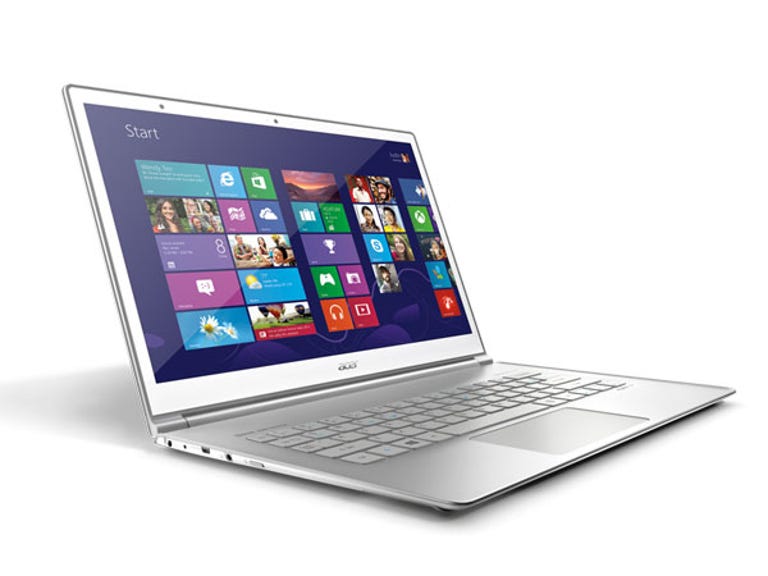 Why You Can Trust CNET
Why You Can Trust CNET Acer Aspire S7 (11.6 inch) review: Acer Aspire S7 (11.6 inch)
Acer takes a step up into premium land with its S7; however, there are still a few rough edges — in particular, battery life.
Acer's going high brow for Windows 8 with its S7. Coming in 11.6-inch and 13.3-inch versions, they both use touchscreens and have full HD IPS panels. It is, for all intents and purposes, a slight freshening up of its earlier S5.
The Good
The Bad
The Bottom Line
Connectivity
- Touchscreen: yes
- USB 3.0: 2
- Video: micro HDMI (VGA via adapter)
- Ethernet: 100Mbps via USB 2.0 adapter
- Wireless: dual-band 802.11n, Bluetooth 4.0
While we wondered how the desktop would look at full HD at 11.6 inches, we had no issues at all. For those who find themselves squinting, moving a notch up to 125 per cent DPI should fix your troubles. Viewing angles were good, and, impressively for a laptop, there was only a small amount of light bleed, emanating from the top.
You can get decent volume out of the speakers, but sound quality isn't great — bring your headphones.
The 11.6-inch model has an aluminium back, which looks impressive, but makes the screen feel a little top heavy, especially when the laptop is held in the hand. There's a cute bit of engineering here — after you open the lid to 90°, the resistance increases markedly. This is to reduce screen wobble when tapping, and we can't say we ever noticed a problem in this regard.
The inside of the laptop follows the same metallic theme, while the bottom is plain, white plastic. It feels impressively light for what it is, coming in at 1.1kg.
The backlit keyboard is welcome, although not particularly bright, glowing a faint aqua colour. While it works fine in darkness, in half-light it's incredibly difficult to see the keys. Acer has also made a few odd choices; while moving the F1-F12 keys to the number keys (and making them activated through the Fn key) helps save space, it's also moved the delete key down next to the arrow keys, and the home/page up/end/page down assignments are just confusing, with the keys small enough to cause errors.
The touch pad is large, and supports standard gestures. An additional welcome gesture is a four-finger swipe up or down, which effectively acts like the Start key on the keyboard. You can't perform the gestures one after the other too quickly, and you have to raise your fingers off the pad afterwards, or they simply get ignored.
Port options are about what you'd expect for a laptop of this size: dual USB 3.0, micro HDMI, microSD and a headset jack are all you get. Acer bundles in a USB to 10/100Mbps Ethernet adapter, along with a micro-HDMI to VGA adapter. Also in the box is a wireless mouse and an incredibly nice laptop sleeve, with a faux-leather exterior and what feels like a soft neoprene interior.
Our review model came with a Core i7 3517U, 4GB of RAM and dual 128GB LiteOn SSDs arranged in RAID 0, for a single 256GB volume. This allows for some impressive speeds, with CrystalDiskMark showing 742.4MBps sequential reads and 689.9MBps sequential writes, and 4K random speeds hitting 13.37MBps reads and 11.38MBps writes. Disk speed is most certainly not a bottleneck here.
Application performance
Choose a benchmark: Handbrake | iTunes | Photoshop | Multimedia
Amongst the Windows 8 laptops we've tested so far, the Aspire does reasonably well, except on the multimedia multitasking test. The most likely issue here (given the identical specs of the 13.3-inch S7) is heat management over a prolonged period, not allowing the S7 to turbo as high as it could.
The S7's arrangement of one intake and one outtake fan at the back proved to be quite whiny and loud during CPU-intensive tasks.
Battery life
We've moved to a new battery test for Windows 8, a modified version of our heavy battery test for Windows 7. We loop a 720p video until battery depletion, with the screen brightness set to 40 per cent, and the ambient brightness adjustment turned off.
Acer doesn't do well at all here. In theory, it shouldn't be Windows 8 causing the battery shortfall, so we're going to bank on the touchscreen drawing power, the full HD IPS screen and a low-capacity battery. Taking the MacBook Air 11 as a baseline and using our old battery tests, the Mac lasts 145 per cent to 180 per cent longer than the Acer. Of course, it isn't touch enabled, nor does it have a full HD IPS screen, but that's a huge deficit.
Our review unit included an extra battery pack that added around two and a half hours to our battery-testing time, but at the time of writing the company has yet to decide whether it is to be an optional extra or included in the bundle.
Conclusion
Acer is taking a step up into premium land with the S7. The AU$1799 price tag might seem steep at first, but given the full HD IPS screen and RAID 0 256GB SSD set-up, it's not too bad. The question is, will the buying public care about these high-end parts, or will they just see the price tag and walk away?
From our perspective, it's a great little machine, but it's crippled by its battery life. If Acer decides to bundle the battery expansion free of charge, that would go some way to mitigating the issue, albeit at the cost of extra weight.


